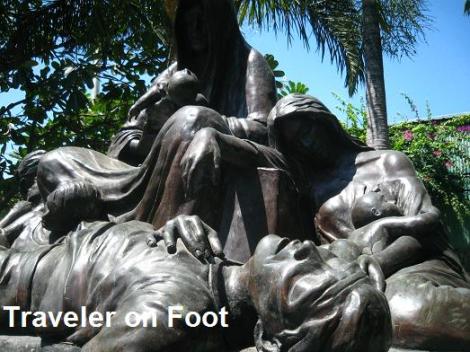
One day we decided to take a calesa for a kutsero-guided tour of Intramuros. After some haggling with the kutsero, we agreed to have a 30 minute tour for 250 pesos. The kutsero-tour guide made quick stops on significant places while he delivered his spiel.
Until we stopped by a pocket garden along General Luna Street called the Plaza Sampalucan. The park has a beautiful sculpture and it is surrounded by tall plants. I thought then that the park was probably named after the tamarind (sampaloc) tree but I didn’t see any tamarind tree in the area. According to the kutsero-tour guide, that park was name after the “sour” (“maasim” like the taste of Sampaloc fruit) experience of the residents of Intramuros who died on that spot during the 1945 Liberation of Manila (after hearing the story, it came to me that the story might be a “kwentong kutsero”).

Since then, Plaza Sampalucan remained a mystery to me until I’ve read a story from Ambeth Ocampo about a scandal that gave the plaza its name. The characters were the busy Governor-General Alonso Fajardo, his bored wife Catalina Zambrano and a handsome ex-Jesuit named Juan Messa.
According to Ocampo, the affair between the governor’s wife and the ex-Jesuit began a Holy Thursday. Ocampo narrates, Gossip about the liaison reached Fajardo who then planned a trap. One day, in May 1621, Fajardo left the governor’s palace with his entourage for Cavite to check on the Dutch who were threatening the colony again. Halfway to Cavite, he left the entourage and returned posthaste to Manila. When he arrived in the palace and found his wife gone, he confronted a page and threatened to plunge a knife into him. The frighten page then spilled the beans: Catalina left disguised as a man and she has done this many times before.
Fajardo proceeded to Juan’s house and saw Catalina, Juan, and a third man entering the door. Having posted his men on the four streets surrounding the house to make sure no one got in or out, he manage to push the door open just as the unnamed man was closing it. Fajardo stabbed this man who rushed out begging for confession but was finished off by the soldiers in the street.
Fajardo ran upstairs and found Juan in a room lighted with two candles. They fought with their swords until Fajardo, sensing that Juan was protected by armor, aimed for the neck and wounded Juan mortally… Juan’s famous last words were “whoever you are, don’t kill me. Consider the honor of your lady.” Fajardo looked for his wife and found her hiding in the attic. He drove his sword into her, but desisted from killing her when she begged forgiveness from him and God.
Fajardo left her half dead to get a priest from the nearby Franciscan church, but came back with a secular priest he met on the street. After the confession that took about thirty minutes, Fajardo killed his wife.
Three corpses were brought to the patio of San Agustin and left overnight for everyone to see. An official investigation was undertaken and hundreds of letters between the lovers were discovered. The case was closed, and in reports to the King of Spain, Fajardo made no mention of the events of May 1621.
It was said that the house of Juan Messa was located on same spot of what is now Plaza Sampalucan. Spanish authorities torn down Juan’s house and ordered the lot to remain vacant. Tamarind trees were planted in the vacant lot to remind people of the romance that gone sour.
Reference: Bonifacio’s Bolo by Ambeth Ocampo
I wonder if there is a place called “Ampalayahan”.
nice piece of history! nice post
Ambeth’s story still did not provide an answer to why the place is called Sampalucan but maybe it did gave a clue to a romance gone sour. Interesting, interesting.
According to an old Manila legend, tamarind trees spontaneously grew on the spot where the wife and her lover used to meet.